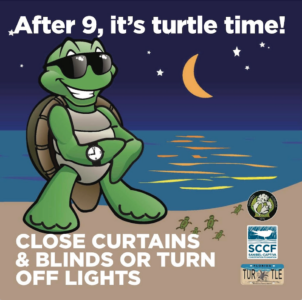City: ‘Share the Shore’ with shorebird, sea turtles

Each year, the city of Sanibel supports the mission of the Sanibel-Captiva Conservation Foundation (SCCF) and its team of staff and volunteers, who monitor the island’s beaches for shorebirds and endangered sea turtles.
The city reported that because the shoreline serves as critical nesting habitat for these wildlife species, beachgoers and boaters are asked to do their part as they enjoy the barrier island sanctuary.
WHAT TO KNOW ABOUT SHOREBIRDS
Shorebird nesting season ranges from February through August. Their eggs are laid in shallow nests, known as “scrapes,” in the sand or seashells. Since the nests are so well camouflaged, they can be accidentally disturbed by beachgoers or their pets.
– Respect posted areas. Avoid posted nesting and resting areas and use designated beach paths or dune walkovers.
– Keep your distance. If shorebirds fly off when you walk by, please step back. When nesting birds are disturbed during incubation, the hot sun can destroy eggs or predators can eat flightless baby birds.
– Never intentionally force birds to fly. When birds are chased or disturbed, they use energy needed for nesting and migration.
– Keep pets away from established nesting areas. Even well-behaved pets can be perceived as a threat by nesting wildlife, so if you take your pets to the beach, keep them restrained or on a leash no more than 8 feet in length (Sanibel Code Section 10-62).
– Keep the beach clean and do not feed wildlife. Food scraps on the beach attract predators such as raccoons and crows that may also prey on shorebirds, eggs and chicks. Litter or other debris can also entangle wildlife, so properly dispose of all waste.
To watch the city’s “Share the Shore with Shorebirds Conservation Video,” visit https://youtu.be/eS6EWByVphs.
For more tips and information, visit https://sancaplifesavers.org/shorebirds/.
WHAT TO KNOW ABOUT SEA TURTLES
Sea turtle nesting season ranges from mid-April through October. Nesting females face many potentially lethal disturbances as they come inshore, including boat strikes, entanglement in fishing line and debris, and disorientations from artificial lighting on the beach. Nesting females or hatchlings that wander inland have an increased risk of exhaustion, dehydration or predation.
– Beachfront lighting ordinances are enforced year-round. Gulf-front property owners are responsible for ensuring compliance with the city’s marine turtle protection ordinances so that artificial lighting from their property does not illuminate the beach and disorient nesting females and hatchlings (Sanibel Code Section 74-181 to 74-183 and Section 126-996 to 126-1002).
– Do not use flash photography, flashlights or phone lights near nesting wildlife. It can cause sea turtles to become disoriented and crawl away from the ocean, putting them at risk.
– Remove furniture and equipment, when not in use, between the hours of 9 p.m. and 7 a.m. Items left on the beach, including beach furniture, toys and trash, can be barriers to nesting or result in entanglement and predation of hatchlings (Sanibel Code Section 126-638).
– Level all sandcastles and fill any holes when you leave for the day. Leave the beach as you found it, so that sea turtles and hatchlings do not become hindered or stuck on their way to nest or during their journey to the water.
Violations should be reported immediately to the Sanibel Police Department at 239-472-3111, Sanibel Code Enforcement at 239-472-4136 or the Natural Resources Department at 239-472-3700.
For questions about the city’s beachfront lighting regulations, contact sandnr@mysanibel.com.

